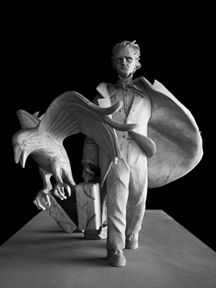By Juliana Stivanicevic
Artist Stefanie Rocknak is a philosopher, but she will tell you that her art objects are not “theories”; theories are neither necessary to explain them nor do they require a theory to do their talking. It would be a mistake, however, to say that her work is not philosophical. Rocknak’s winning sculpture Poe Returns to Boston will certainly give Boston something to inspire, something to marvel at, and something to think on.
In 2011, the Edgar Allan Poe Foundation of Boston (PFB) issued a call to artists that resulted in 265 proposals from which three finalists were chosen. After a period during which about 1,500 people commented on these designs, Rocknak’s Poe Returns to Boston was selected. Boston Mayor Tom Menino has said that the sculpture will “inspire residents and future writers alike for generations to come,” and Poe Foundation Chair Paul Lewis notes that “with its energetic stride and iconic images…this statue will both delight Poe fans and provide a new focal point for the celebration of Boston’s rich literary heritage.”
When selected as a finalist, Rocknak knew she wanted to create something that would “reflect Poe’s complicated relationship to Boston.” It should capture both the bond to his birthplace and the adult Poe’s notorious relationship with Boston’s literary elite. “Just off the train, the figure is walking south towards his place of birth…Poe, with a trunk full of ideas—and worldwide success—is finally coming home,” she explains. “His expression is complex. He is determined and his stride is decisive. His face reflects a mixture of pain, anger, and sadness, and from some angles, a subtle sense of hope. Boston is not claiming Poe, Poe is claiming Boston.”
For Rocknak, the unique relationship between art and philosophy in her work lies in a desire to understand and visually capture certain human expressions and relationships. And truly, in contemplating Poe Returns to Boston, are we not also contemplating a narrative of our own being? What is it to come back again to the place where we once were? How then do we come to understand our selves and our relationship to that place?
This marvelous narrative comes full circle in Poe’s triumphant return. “He has not only left his mark on the world, he has left it on the city of his birth. His ideas are jumping off the page and cascading out of his trunk; a heart lies just behind him, and an oversized Raven explodes to the south,” Rocknak says. “The Raven, which has become symbolic of Poe’s brooding creative spirit, visually reflects Poe. They are one, heading up-wind towards their final resting place.”
Poe Returns to Boston is an incredible work of art that does not attempt to recreate, revel in, or critique the past; it admires the past and appropriates this sentiment in a way that makes it her own—a strikingly present representation of our own dreams and ambitions. Rocknak praises the ability to think and create among the advantages of a liberal arts education: “liberal arts students tend to be especially adaptive and open-minded, which I think, makes for a richer, more enjoyable life.” She greatly values her membership in Phi Beta Kappa for always reminding her to challenge herself and “to maintain a standard of excellence, even if I can’t always live up to it.”
Stefanie Rocknak graduated from Colby College in 1988 and was inducted into Phi Beta Kappa her senior year. She received her Ph.D. in philosophy from Boston University in 1998. She is an associate professor of philosophy at Hartwick College in Oneonta and recently published a book on David Hume. Rocknak is an award-winning member of the Sculptor’s Guild whose artwork has appeared in numerous publications and in more than forty exhibitions including at the Smithsonian.
Juliana Stivanicevic is junior at the University of California, Berkeley majoring in rhetoric. UC, Berkeley is home to the Alpha of California chapter of Phi Beta Kappa.




